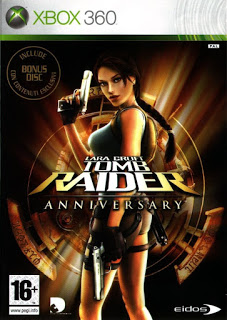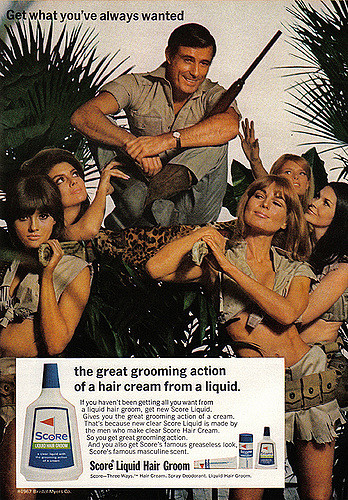Videogames: Tomb Raider Anniversary
Language and Audience
Analyse the game cover for Tomb Raider Anniversary (above).
1) How does the cover communicate the genre of the game?
- Colour scheme- brown, gold, dark and mysterious alludes to achievement and ancient civilisation
- In the background- is the artifact that she is on a quest for (the Scion of Atlantis)
- Lara's costume- shorts, tank top, backpack, gloves, etc. alludes to an adventure (also an intertextual reference of Indiana Jones)
- Font choice- alludes to the quest genre
- The guns she is holding- very clear and put in spotlight which alludes to the action/adventure genre
2) How does the pose and costume of the character appeal to primarily male audiences?
- Costume- very revealing and impractical for the task at hand (male gaze- Mulvey)
- The gun holsters on her thighs resemble lingerie suspenders so Lara is being sexualised for the pleasure of a male audience
- Heavy makeup- smoky eyes and red lips further sexualises Lara
- The pose she is in is very unrealistic and is a deliberate attempt by creators to show off her body in a sexual way. The lighting further emphasises certain parts of her body that would appeal to a male audience
- The gun is a phallic symbol
3) How might the cover be read as empowering for female gamers?
- A female is the main character and she is placed on the front cover with no males. She is represented as being strong, powerful, independent, intelligent and knowledgable in the game which is something that can be celebrated.
- The fact that she is holding two guns could also be read as being empowering because she is represented as being able to protect herself, a positive change to the usual damsel in distress stereotype of women in videogames.
Gameplay analysis
Watch the following gameplay clips again:
1) What does the gameplay for Tomb Raider Anniversary involve?
- Third person perspective
- Player has some control over camera angle and placement
- Gunplay offers close to Lara's POV (almost first person)
- Cutscenes and action scenes contain reaction shots of Lara- creates empathy, more cinematic, establishes Lara as a hero
2) Write an analysis of the media language choices in the construction of the game: e.g. genre, narrative, mise-en-scene, camera shots etc.
Mise-en-scene
- Establishes genre and atmosphere - ancient ruins, rivers and ravines, low-key lighting
- Revealing + impractical clothing
- Gun placement also emphasises Lara's physique
Narrative
- Action + enigma codes
- Construction- Checkpoints are mini narrative resolutions
- Lifebar flashes when health is low- creates tension
- There are puzzles as well as physical challenges
Animation & movement
- Camera angles are low - sexualisation of Lara
- Lara sways her hips when she walks, stands or runs
- Lots of action- running, jumping, hanging on ledges (empowering for women)
Sound
- Lara grunts when she does physical activities- grunting with effort arguably sexualises the physical challenges
- Non-diegetic music used to establish tension and genre
3) Analyse the clips for audience pleasures, applying audience theory and considering media effects
- Checkpoints- constant reward (diversion)
- Cutscenes- narrative and intertextuality (personal relationships)
- Nostalgia from the original game
- Intellectual challenge- puzzle solving
- Lara Croft is a breakthrough for female gamers (independent, smart)
- Skill with controller- competence
- Cultivation theory (Gerbner)- normalises the sexualisation of women
- Male gaze (Mulvey)
Representations
Read this NME feature on the evolution of the character of Lara Croft. Answer the following questions:
1) Note the statistics in the opening paragraph.
- Lara Croft has appeared on more than 1,100 magazine covers
- Over 58 million videogame units of Tomb Raider sold
2) How does the article describe the cultural change in society and the media since the early 00s?
The article discusses how the conversation around women's equality in society has changed entirely since the 2000s. Examples given to prove this point include- women appearing in popular films, the #metoo campaign, and the fact that Lara Croft now wears cargo pants and 'the focus is on her attitude, intelligence and athleticism, rather than her improbable polygon body.'
3) How was the original 1996 Lara Croft received by audiences and critics?
The original 1996 Lara Croft came as a pleasant surprise to everyone. It was one of the first video games to feature a female protagonist so everyone was excited. 'She was strong, smart and had an amazing job: she was already a role model.'
4) What did the 2013 re-launch do differently – and how successful was it?
Lara Croft received a makeover in 2013. She no longer wore hot pants and had a 'barbie' physique. She now wore cargo pants and had abs, her skin covered in dirt, blood and scars - she actually looked like she raided tombs. The focus of the game shifted to Lara's face, aiming to show a range of complex emotions to reveal an emotional background and allow audiences to sympathise with her. Lara was also given a best friend in the game (Samantha Nishimura).
The game was a huge success- it became the best selling game in the history of the franchise.
5) How is ‘woke Lara’ defined in the conclusion of the feature?
Woke Lara is described as being determined, courageous and a lot of physical ability. She is 'officially ready to raid the box office'.
Now read this feature – Tomb Raider’s Lara Croft: feminist or femme fatale?
1) Why is Lara Croft considered a “polarising figure among gamers”?
She can either be regarded as a feminist role model who is a 'tough, agile archaeologist who could outmatch Indiana Jones' or as a sex symbol that was 'noticed more for her voluptuous physique and revealing attire - a tank top and short shorts.'
2) How did the limitations of game construction in the 1990s help to establish the way female characters were animated?
Back when graphics weren't anywhere near as good as they are now, it could be difficult to distinguish between males and females on a 32-bit console. Flowing hair was very difficult to design. Therefore, giving females large hips and breasts was the easiest way to feminise them.
3) Why were Lara Croft’s physical attributes emphasised in the original games?
The original Lara Croft was extremely sexualised as a marketing strategy. Heather Stevens, a video game designer on the original game, states that 'We knew a different Lara Croft.'
4) How does Anita Sarkeesian describe Lara Croft?
Anita Sarkeesian has a very negative view of Lara Croft. She states that "She is one of the most iconic representations of women in gaming, but that doesn't mean it's a good thing, she is a hyper-sexualised character that promotes a deep objectification of women."
Sarkeesian highlights how the game is constructed to portray Croft as a sex object- the camera angles focus on her rear end, forcing the player's attention to it. "With Lara Croft, you see her entire body running around in her hot pants," she said. "That encourages players to look at her as a sex object."
5) Why has Lara Croft’s appearance and characterisation changed over time?
Lara Croft's appearance changed as game developers released more women were being drawn to video games. In 2013, Crystal Dynamics rebooted the franchise and gave her a more natural look, including trousers. "The goal was to make her a relatable character, one that was believable," Since her introduction, fans have identified with her commanding demeanour and confidence as well as her sex appeal
Industries
1) Why is Lara Croft such an iconic figure in the gaming industry?
Lara Croft is such an iconic figure in the gaming industry because of the fact that she was one of the first female protagonists to appear in video games. She was independent, strong and smart which allowed many female gamers to take a liking to her.
2) What products and spin-offs have featured Lara Croft or the Tomb Raider brand?
- There have been to feature movies with Angelina Jolie
- A new reboot of the Tomb Raider films features Alicia Vikander
- There have been many mobile spin-offs (such as Lara Croft Go)
3) Why might Lara Croft be considered a postmodern icon?
Lara Croft might be considered a postmodern icon because of the fact that she has become so well known in the media to the point where other brands had used Lara Croft to advertise their own products, as if she is a real person.
She has also become an ideal costume for events like ComicCon, allowing audiences to become her.
4) Why is Tomb Raider Anniversary a 'case study in conglomerate ownership'?
Tomb Raider anniversary is a case in conglomerate ownership because of the fact that the game has been owned by multiple companies throughout its lifetime. The original 1996 game was developed by Core Design, who were then bought by Eidos Interactive (publishers of the original game) and Eidos was then bought by Square Enix- publishers based in Japan who develop and publish games across multiple platforms, including consoles, phones, tablets and online.
Grade A/A* extension tasks
Link Tomb Raider Anniversary to our work in the unit so far:
1) What examples from the Tomb Raider franchise are included in Anita Sarkeesian's video series 'Tropes vs Women in Video Games'?
Grade A/A* extension tasks
Link Tomb Raider Anniversary to our work in the unit so far:
1) What examples from the Tomb Raider franchise are included in Anita Sarkeesian's video series 'Tropes vs Women in Video Games'?
Anita Sarkeesian discusses how the Tomb Raider franchise has strategically placed Lara Croft's body at the center of the game. It is always represented in a way to allow players to direct their focus to it. The fact that she wore short shorts in the original games highlights this point. Furthermore, Sarkeesian talks about how the third person perspective of the game helps Lara Croft's body be put for show.
https://youtu.be/ujTufg1GvR4 - 0:57-1:30
2) How can we apply Liesbet van Zoonen's work to Lara Croft and Tomb Raider?
Van Zoonen discusses how 'Gender is constructed through media language'. This is indeed true in the case of Lara Croft because her body is presented in an overly sexualised manner (with the low camera angles and revealing clothing) to allow the presumed heterosexual male players to gain some form of pleasure or gratification.
However, Van Zoonen also discusses how 'constructions reflect cultural and historical contexts'. While the objectification of Lara Croft in the earlier games may have been deemed normal because of the time, they have now become unacceptable which is why the reboot in 2013 gave Lara Croft cargo pants instead of shorts.



Comments
Post a Comment